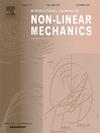Shear-imposed thin film flow with variable fluid properties
IF 2.8
3区 工程技术
Q2 MECHANICS
International Journal of Non-Linear Mechanics
Pub Date : 2025-05-15
DOI:10.1016/j.ijnonlinmec.2025.105140
引用次数: 0
Abstract
This study focuses on the stability of a thin liquid film on an inclined plane under the influence of external shear and thermal effects. The Navier–Stokes equation, coupled with the energy equation, is employed, considering temperature-dependent fluid properties that vary linearly with small temperature changes. The instability mechanisms are examined for shear acting in the same or opposite direction as the fluid flow, with temperature-dependent fluid properties. A fully nonlinear free surface evolution equation for the film thickness is derived to describe interfacial dynamics. Normal-mode analysis in linear stability analysis is conducted to explore the impact of temperature-dependent fluid properties and imposed shear direction on flow dynamics. Additionally, weakly nonlinear stability analysis is performed to identify supercritical or subcritical regions beyond the linear regime. Numerical simulations using the spectral method are carried out, confirming the theoretical model’s predictions of instability thresholds. In addition to the inclined plane configuration, the study also considers a thin liquid layer resting on a planar heated substrate. In this setting, where gravitational effects are negligible, rupture phenomena induced by van der Waals forces are analyzed. An evolution equation for the film profile is derived using lubrication theory, and numerical simulations reveal that externally applied shear can counteract the accelerated rupture driven by temperature dependent fluid properties.
具有可变流体特性的剪切施加薄膜流动
本文主要研究了在外部剪切和热效应影响下斜平面上液体薄膜的稳定性。考虑了随温度变化而线性变化的流体性质,采用了Navier-Stokes方程和能量方程。研究了与流体流动方向相同或相反的剪切作用的不稳定性机制,具有温度依赖的流体性质。导出了薄膜厚度的完全非线性自由表面演化方程来描述界面动力学。采用线性稳定性分析中的正态模态分析,探讨随温度变化的流体性质和施加的剪切方向对流动动力学的影响。此外,还进行了弱非线性稳定性分析,以确定超出线性区域的超临界或亚临界区域。利用谱法进行了数值模拟,验证了理论模型对不稳定阈值的预测。除了斜面结构外,该研究还考虑了平面加热基板上的薄液体层。在这种情况下,引力效应可以忽略不计,我们分析了范德华力引起的断裂现象。利用润滑理论推导了膜型的演化方程,数值模拟结果表明,外部剪切可以抵消温度相关流体特性导致的加速破裂。
本文章由计算机程序翻译,如有差异,请以英文原文为准。
求助全文
约1分钟内获得全文
求助全文
来源期刊
CiteScore
5.50
自引率
9.40%
发文量
192
审稿时长
67 days
期刊介绍:
The International Journal of Non-Linear Mechanics provides a specific medium for dissemination of high-quality research results in the various areas of theoretical, applied, and experimental mechanics of solids, fluids, structures, and systems where the phenomena are inherently non-linear.
The journal brings together original results in non-linear problems in elasticity, plasticity, dynamics, vibrations, wave-propagation, rheology, fluid-structure interaction systems, stability, biomechanics, micro- and nano-structures, materials, metamaterials, and in other diverse areas.
Papers may be analytical, computational or experimental in nature. Treatments of non-linear differential equations wherein solutions and properties of solutions are emphasized but physical aspects are not adequately relevant, will not be considered for possible publication. Both deterministic and stochastic approaches are fostered. Contributions pertaining to both established and emerging fields are encouraged.

 求助内容:
求助内容: 应助结果提醒方式:
应助结果提醒方式:


